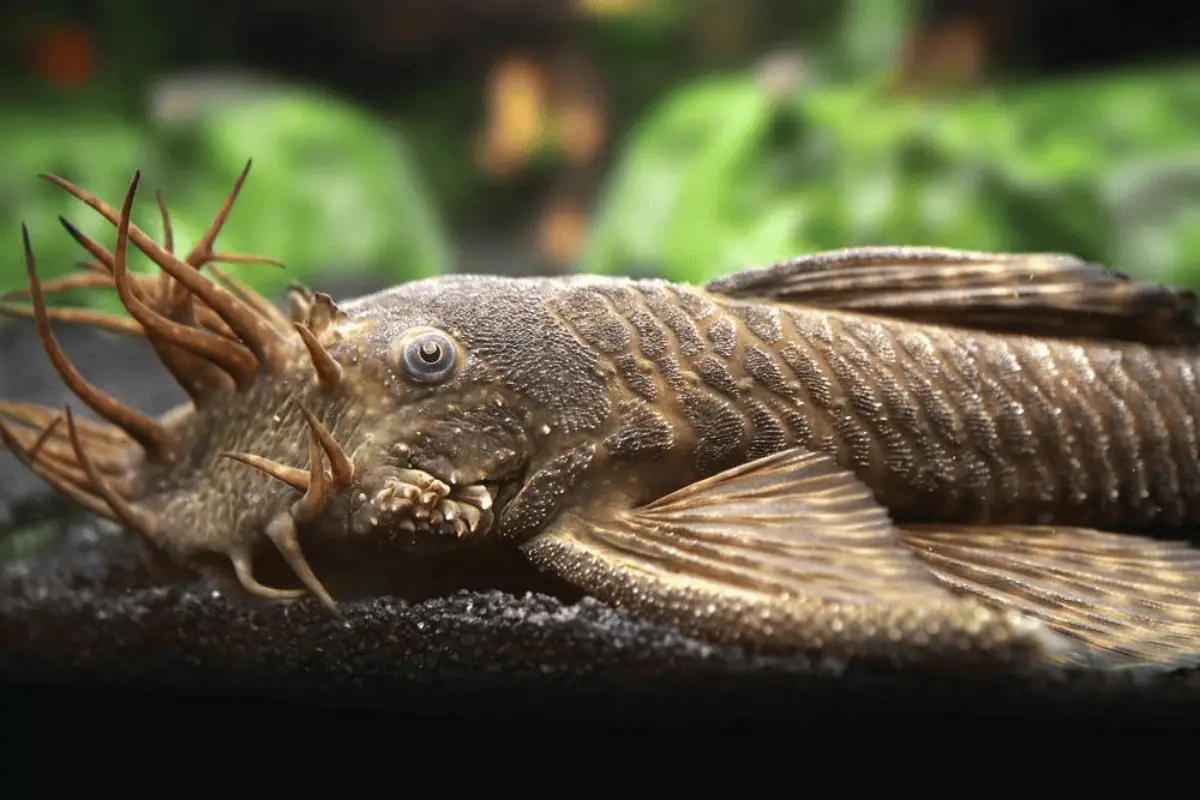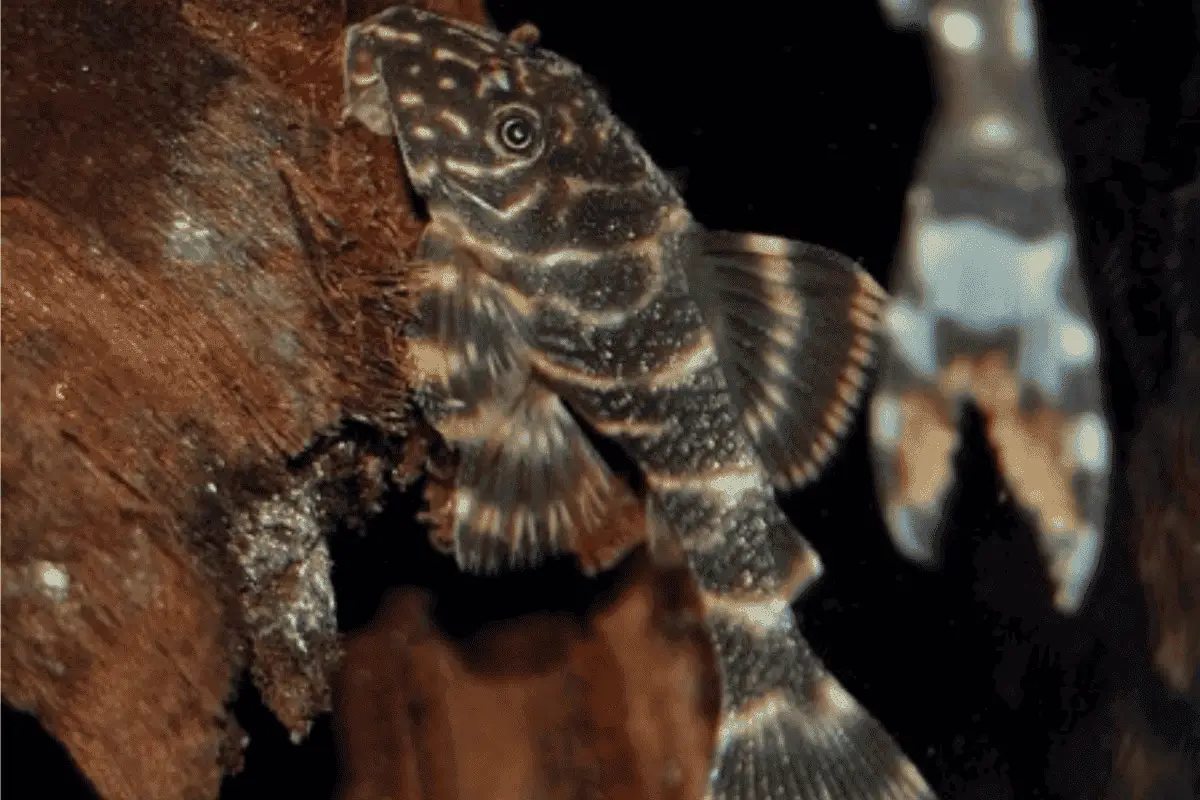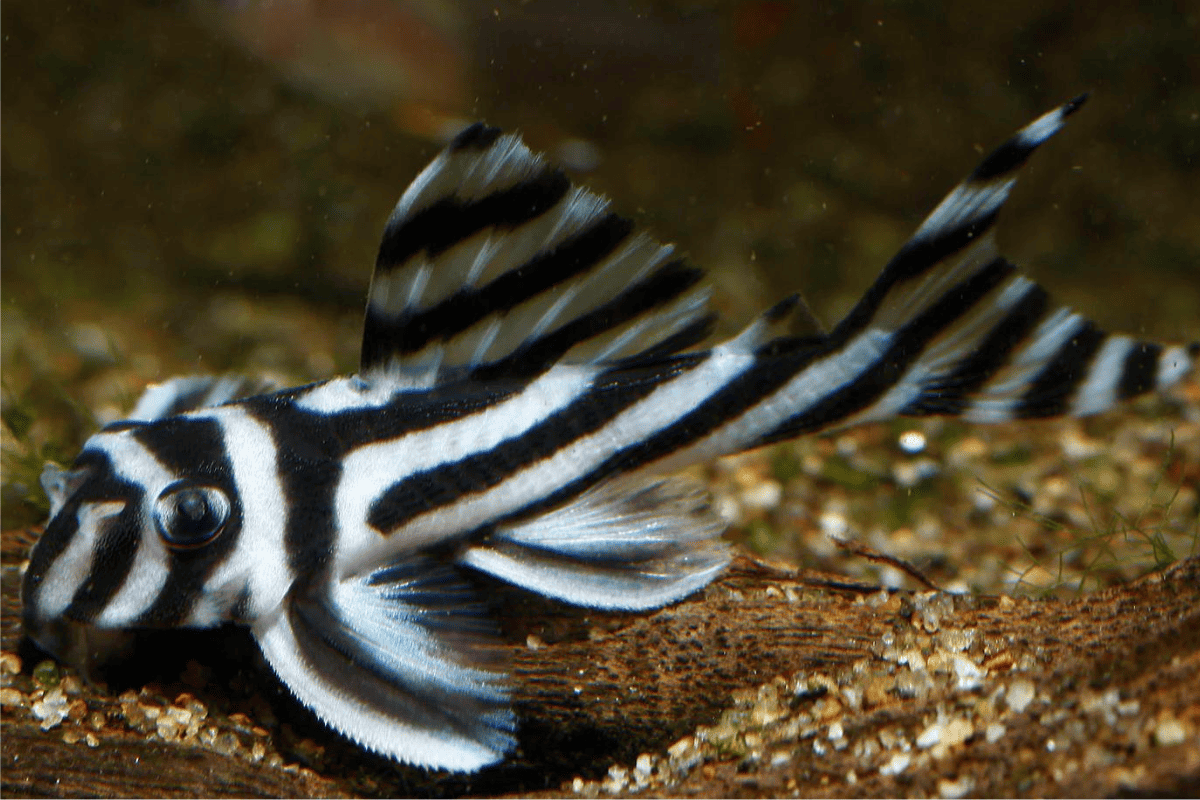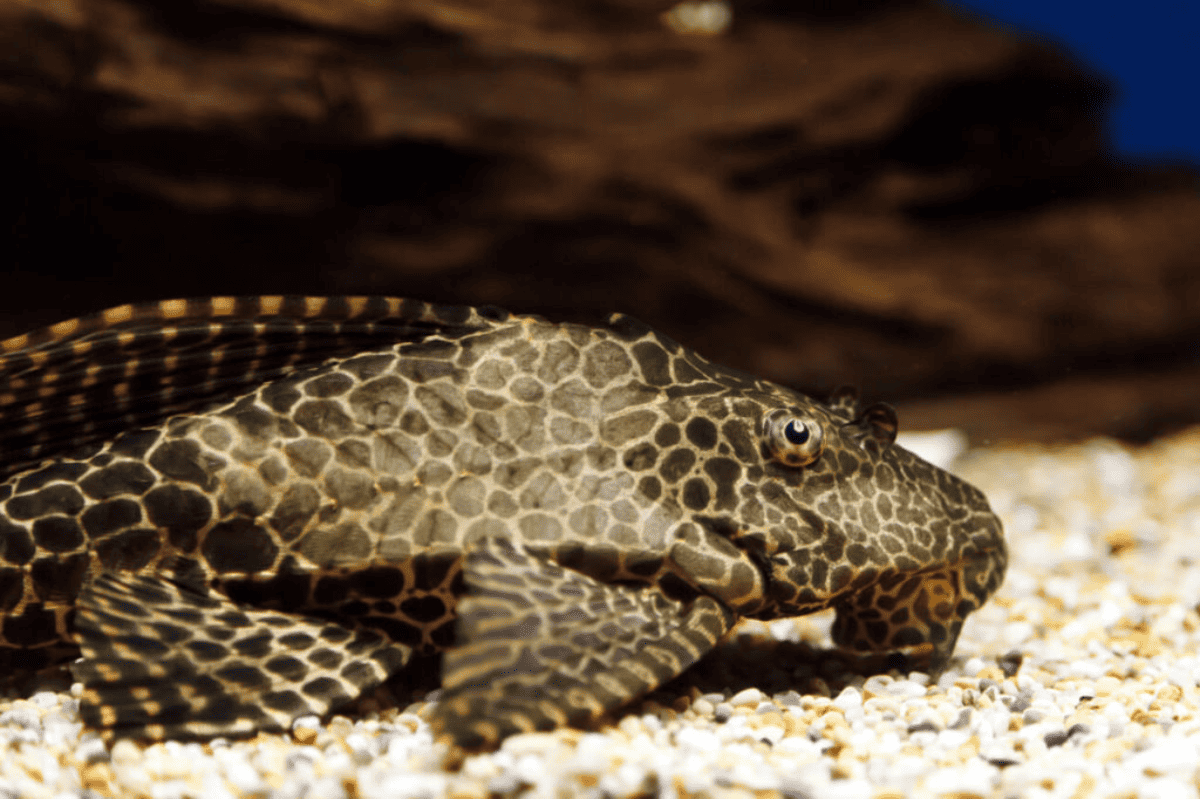One of the first questions I asked myself when I got my first Pleco was whether I could get another one to pair with it.
I wasn’t sure if two Plecos can actually share a tank, and if so, which Pleco species work best with each other.
In this article, I’ll dive deeply into this topic, and cover all the essential information for keeping more than one Pleco in a single tank. Let’s get started.
Also Read: Pleco Fish Tank Mates

Can Two Plecos Live Together?
Yes, you can keep more than one pleco in a tank, but there are some important considerations:
1. Tank Size
The environment Plecos live in is vital for their health. Their growth potential and the amount of waste they produce make tank size a top priority.
- Growth Space: Larger Pleco species need enough room to grow properly. Keeping them in tight spaces can lead to stress, stunted growth, and health issues.
- Waste Management: Two Plecos can create a lot of waste. Tanks that are too full struggle with waste disposal, resulting in toxin accumulation.
- Swimming Area: Giving Plecos enough room supports their natural movements, lowering stress and enhancing their well-being.
2. Species & Behavior
The harmony of an aquarium depends on the specific Pleco species and their individual traits.
- Species Traits: Different Pleco species have varied behaviors. It’s important to understand these to avoid conflicts.
- Size Matters: A size mismatch can result in one Pleco overpowering the other, leading to stress and potential injury.
- Starting Together: Introducing them at the same time can minimize territorial issues as they mature, having settled their spaces early on.
3. Hiding Spots
Given Plecos’ territorial nature, plenty of hideouts are crucial.
- Daytime Retreat: A safe place for Plecos to retreat during their inactive periods ensures they are stress-free and protected.
- Claimed Spaces: Having individual territories reduces potential aggressive behaviors.
- Decor Benefits: Besides aesthetic appeal, certain decors function as a necessary refuge for these fish.

4. Nutrition & Meal Times
Catering to the varied diet of Plecos, especially with multiple of them, is vital.
- Dietary Variety: Diverse diets are crucial for their overall health, ensuring they receive all essential nutrients.
- Feeding Volume: Adequate feeding ensures neither Pleco feels food-deprived, reducing potential food-related disputes.
- Watchful Eye: Ensuring both Plecos get adequate nutrition prevents malnutrition or one dominating the other during feed times.
5. Water Health
Maintaining the right water conditions is essential for Pleco well-being, given their sensitivity to chemical shifts and impurities.
- Stable Conditions: Fluctuations can cause stress and negatively impact their immune system, making them more susceptible to diseases.
- Filtration Necessity: High-quality filtration is a non-negotiable requirement given the substantial waste Plecos produce. I personally got the Fluval C4 Power Filter (link to Amazon) and I couldn’t be more satisfied.
- Consistent Checks: Regular monitoring ensures that toxic compounds don’t accumulate, thereby securing optimal health conditions.
6. Aquarium Companions
Picking suitable companions is vital to lessen tension and ensure peace in a Pleco-centric tank.
- Peaceful Partners: Peaceful tank-mates reduce the chances of unnecessary stress and potential injury.
- Depth Dynamics: Having tank-mates that don’t invade the Plecos’ preferred spaces minimizes territorial disputes.
- Size & Temperament Sync: Unsuitable tank-mates can pose a threat by either being potential prey or overly aggressive contenders.

Which Pleco Species Are Good in Pairs?
In the realm of pairing Plecos, certain species are more suitable mainly because they maintain a smaller size.”
Here’s a concise table illustrating the size of each Pleco, the minimum tank size for one fish, and the minimum tank size for two plecos of the same species:
| Pleco Species | Max Size (inches) | Min Tank Size for 1 (gallons) | Min Tank Size for 2 (gallons) |
| Bristlenose Pleco (Ancistrus) | 4-6 | 30 | 55 |
| Clown Pleco (Panaqolus maccus) | 3-4 | 20 | 30 |
| Rubber Lip Pleco (Chaetostoma) | 7 | 30 | 50 |
| Peppermint Pleco (Parancistrus) | 7 | 30 | 55 |
| Zebra Pleco (Hypancistrus) | 3-4 | 20 | 30 |
| Candy Stripe Pleco (Peckoltia) | 5 | 25 | 40 |
| Dwarf Pleco (Pseudancistrus) | 3-4 | 20 | 30 |
1. Bristlenose Pleco (Ancistrus spp.)

The Bristlenose Plecos, due to their smaller stature, are frequently paired by aquarists and breeders.
- Size Advantage: Growing to a manageable 4-6 inches, Bristlenose Plecos don’t demand extensive territories like larger Pleco species.
- Tank Recommendations: For one, a 30-gallon tank suffices; however, for a pair, a 55-gallon or larger is advised to ensure ample space and minimize territorial disputes.
- Peaceful Pairings: With individual hiding spots and early introductions, Bristlenose Plecos can cohabit peacefully, especially when paired for breeding.
2. Clown Pleco (Panaqolus maccus)

With their distinctive patterns, Clown Plecos are both visually striking and amenable to paired housing due to their size and disposition.
- Compact Size: Reaching adult sizes of 3-4 inches, Clown Plecos are well-suited for smaller aquarium setups.
- Tank Needs: A 20-gallon tank is adequate for a single Clown Pleco, but if you’re considering a pair, a 30-gallon or larger ensures comfortable living quarters.
- Resource Sharing: As long as there’s abundant driftwood for both, paired Clown Plecos can share a tank without significant friction.
3. Rubber Lip Pleco (Chaetostoma formosae)

These Plecos, favored for their peaceful nature, are an interesting choice when considering pairs.
- Medium Size: Attaining a size of about 7 inches, Rubber Lip Plecos sit in the mid-range in terms of Pleco sizes.
- Tank Specifications: A 30-gallon tank is suitable for one Rubber Lip Pleco, but for a pair, it’s prudent to opt for a 50-gallon or larger tank.
- Harmonious Living: Given sufficient hiding spots and a varied diet, Rubber Lip Plecos exhibit minimal aggression, making a pair manageable.
4. Peppermint Pleco (Parancistrus nudiventris)

This unique Pleco can be a pairing option, provided their distinct needs are catered to.
- Rare Size: Peppermint Plecos can reach sizes up to 7 inches, necessitating spacious accommodations.
- Tank Considerations: A 30-gallon tank is sufficient for a solo Peppermint Pleco, but to house a pair comfortably, a tank of 55 gallons or more is recommended.
- Habitat Preferences: Emphasizing multiple caves and hiding spots will reduce potential disputes, ensuring both Plecos have their own resting spaces.
5. Zebra Pleco (Hypancistrus zebra)

The Zebra Pleco, famed for its striking black and white bands, is a smaller species often kept by enthusiasts and can be housed in pairs under the right conditions.
- Striking Size: Zebra Plecos grow to a modest 3-4 inches, making them one of the smaller Pleco varieties.
- Tank Guidelines: A 20-gallon tank is suitable for one Zebra Pleco, but if you’re housing a pair, opt for 30 gallons or more to give each ample territorial space.
- Specific Habitat Preferences: Zebra Plecos naturally prefer caves. When setting up for a pair, include multiple caves and hideouts to reduce territorial tensions.
6. Candy Stripe Pleco (Peckoltia vittata)

Characterized by its striking stripe pattern, the Candy Stripe Pleco makes a charming pair addition with the right habitat.
- Size Considerations: Growing up to 5 inches, Candy Stripe Plecos require sufficient room to thrive.
- Tank Preferences: While a 25-gallon tank suits a single Candy Stripe Pleco, a duo would appreciate a 40-gallon tank or even larger.
- Peaceful Cohabitation: When given sufficient resources and hideaways, these Plecos can coexist harmoniously, with their peaceful nature allowing for minimal conflicts.
7. Dwarf Pleco (Pseudancistrus spp.)

As the name suggests, the Dwarf Pleco is one of the more compact species, making it an intriguing choice for those considering paired Pleco housing.
- Compact Contenders: Dwarf Plecos usually attain sizes around 3-4 inches, making them suitable for more modest tank dimensions.
- Tank Considerations: While a 20-gallon tank can comfortably host a single Dwarf Pleco, opting for a 30-gallon or larger tank ensures both members of a pair have ample space.
- Harmonious Habitat: With distinct territories, typically demarcated by hiding spots like caves or driftwood, paired Dwarf Plecos can share a space with reduced territorial tensions.
Possible Plecos Combinations
Pairing Plecos can be a nuanced decision. Compatibility depends on temperament, size, environmental requirements, and sometimes even individual personalities.
The table below provides a guideline on pairing recommendations for each Pleco species:
| Pleco Species | Best Paired With |
| Bristlenose Pleco | Dwarf Pleco, Clown Pleco, Rubber Lip Pleco |
| Clown Pleco | Bristlenose Pleco, Rubber Lip Pleco, Dwarf Pleco |
| Rubber Lip Pleco | Clown Pleco, Bristlenose Pleco, Dwarf Pleco |
| Peppermint Pleco | Zebra Pleco, Dwarf Pleco, Candy Stripe Pleco |
| Zebra Pleco | Peppermint Pleco, Dwarf Pleco, Bristlenose Pleco |
| Candy Stripe Pleco | Peppermint Pleco, Zebra Pleco, Dwarf Pleco |
| Dwarf Pleco | Bristlenose Pleco, Clown Pleco, Zebra Pleco |
What Is the Minimum Tank Size for Two Plecos?
The minimum tank size for two Plecos largely depends on the specific species, as their growth potential varies.
However, as a general rule, two small to medium-sized Plecos would require at least a 40-gallon tank.
- Size Variances: Some Plecos, like the common pleco, can grow up to 18 inches, necessitating a larger tank than, say, a Clown Pleco.
- Space and Health: Overcrowding can lead to stress, increased waste, and health issues for Plecos, emphasizing the need for adequate space.
- Active Night Behavior: Plecos, being nocturnal, need enough room to move freely, particularly during nighttime hours.

How Many Plecos Can Live Together?
The number of Plecos that can coexist in one tank depends on the tank size and the specific Pleco species. In general, the larger the tank, the more Plecos you can comfortably house.
- 20-Gallon Tanks: Suitable for one small Pleco species like the Clown or Dwarf Pleco.
- 40-Gallon Tanks: Can accommodate two medium-sized Plecos, ensuring they both have ample space.
- 55-Gallon Tanks: This tank size is ideal for two to three small to medium Plecos or one large Pleco.
- 75-Gallon Tanks: A tank this size can comfortably house three medium-sized Plecos or two larger ones.
- 100-Gallon Tanks and Above: Suitable for multiple Plecos, especially if mixing small and large species, always ensuring enough space.
Can You Have Two Bristlenose Plecos Together?
Yes, two Bristlenose Plecos can live together harmoniously, especially if provided with ample space and hiding spots. However, specific conditions should be met.
- Tank Size: A minimum of 55 gallons is ideal for two Bristlenose Plecos, considering their growth potential.
- Territorial Behavior: Bristlenose Plecos can be territorial, so providing multiple hiding spots minimizes potential disputes.
- Gender Ratio: Keeping a male and female pair can reduce territorial aggression, though breeding might then become a consideration.
Can Two Different Plecos Breed?
No, while Plecos of different species may exhibit mating behaviors, successful interbreeding resulting in viable offspring is rare.
It’s more common for Plecos of the same species to mate and produce fry.
- Genetic Differences: Different Pleco species have distinct genetic makeup, making successful crossbreeding a challenge and often unfruitful.
- Mating Rituals: While Plecos from different species might display mating dances or behaviors, this doesn’t necessarily equate to successful breeding.
- Hybrid Instances: On the rare occasion that different Plecos interbreed, the offspring, if viable, may have unpredictable traits and could face health issues.

How to Introduce a Pleco to Another Pleco
When adding a new Pleco to a tank with an established Pleco, careful steps can ensure both remain healthy and stress-free. The introduction should be systematic and monitored.
- Quarantine First: Keep the newcomer in a separate 10-20 gallon tank for 2-3 weeks, ensuring it’s free from illnesses.
- Rearrange Decor: Modify at least 50% of the tank’s layout, disrupting previous territories and reducing immediate territorial disputes.
- Shared Space: For 1-2 days, use a transparent container inside the main tank so Plecos can see, but not touch each other.
- Monitor Behavior: During the first 48 hours of free cohabitation, observe for signs of aggression, like chasing or flaring.
- Multiple Hideouts: Install 2-3 caves or pieces of driftwood per Pleco, providing personal refuges to minimize conflicts.
Tips for Keeping Multiple Plecos Together
Harmoniously housing several Plecos demands careful planning and consistent maintenance. Here are practical steps to ensure their cohabitation thrives.
- Sizeable Tank: Opt for a minimum of 55 gallons for two medium Plecos, granting sufficient space for natural behaviors.
- Regular Cleaning: Plecos produce ample waste; hence, 20% water changes weekly maintain optimal water quality.
- Diverse Diet: Offer varied foods like algae wafers, blanched vegetables, and shrimp pellets to meet diverse dietary needs. When it comes to Plecos, I usually recommend the Invert Aquatics Mini Algae Discs (link to Amazon).
- Observant Feeding: Feed Plecos in different tank zones, reducing food competition and ensuring each gets its share.
- Check Compatibility: Before adding, research Pleco species compatibility to avoid overly aggressive combinations.
- Avoid Overstocking: Stick to a general rule of one Pleco per 25-30 gallons to prevent territorial stress.
- Nighttime Activity: Since Plecos are nocturnal, use dimmed lights post-dusk, letting them explore and feed comfortably.

Will a Pleco Eat Another Pleco?
No, Plecos aren’t known to eat other Plecos, but they might display aggressive behaviors, especially in confined spaces or over territorial disputes.
It’s essential to ensure that both Plecos are well-fed and have adequate space to minimize these issues.
- Territorial Behavior: If one Pleco invades another’s space, they might nip or chase each other, but not consume one another.
- Size Disparity: In rare cases, a significantly larger Pleco might try to feed on a much smaller, weaker one, especially if food is scarce.
- Feeding Habits: Plecos mainly feed on algae, detritus, and some provided food, not on fellow Plecos, but ensuring a varied diet helps avert potential aggression.
Reasons Why You Should Not Keep Two Plecos Together
While many aquarists successfully keep multiple Plecos, there can be challenges that may make cohabitation tricky or even detrimental for the fish.
- Territorial Aggression: Plecos can be fiercely territorial, leading to stress, injury, or even death when fighting for space.
- Waste Production: Housing two Plecos increases bioload significantly, demanding more frequent water changes and filtration.
- Tank Size Issues: A too-small tank for two Plecos can lead to water quality issues, increasing the risk of diseases.
- Food Competition: Two Plecos might compete for the same food resources, especially if their diet isn’t adequately diversified.
- Stress Indicators: Watch for clamped fins, hiding, or frantic swimming, which suggest the Plecos aren’t cohabiting peacefully.
Also Read: Can Plecos And African Dwarf Frogs Live Together?

Can You Have Two Algae Eaters in One Tank?
Yes, you can keep multiple algae eaters in one tank, provided they have enough space and are compatible.
However, it’s essential to ensure a varied diet and minimize territorial disputes.
- Otocinclus Catfish: Often called “Otos,” these are small, schooling fish, ideal for a 20-gallon tank, which feed on soft algae.
- Siamese Algae Eater (SAE): Active and peaceful, SAEs prefer tanks of 30 gallons or more and mainly target hair algae.
- Amano Shrimp: These shrimp are effective algae eaters, thriving in tanks of 10 gallons or larger, and feed on various algae types.
- Nerite Snails: Perfect for smaller tanks, these snails voraciously consume algae, especially on surfaces like glass.
- Mollies: While primarily omnivores, Mollies will graze on algae, doing well in tanks of 20 gallons or more, complementing Plecos in larger setups.
Conclusions
For quick readers, here’s a short recap:
- Plecos can coexist in a tank but require careful consideration of tank size, species temperaments, and the provision of sufficient hiding areas.
- Maintaining proper water quality is vital for Plecos, and they benefit from consistent water parameters and robust filtration.
- Dietary needs of Plecos include algae, wafers, vegetables, and proteins. Regularly monitoring feeding ensures all get their nutritional share.
- Bristlenose, Clown, and Zebra Plecos are among the species well-suited for pairing in tanks, given their size and nature.
- When introducing a new Pleco to an existing one, it’s essential to quarantine, rearrange tank decor, monitor interactions, and provide multiple hiding spots.
